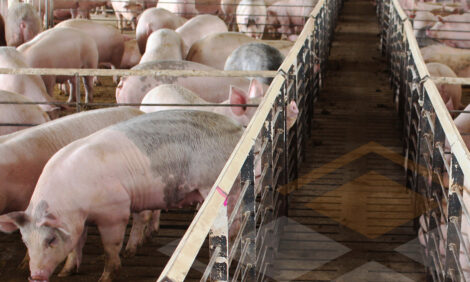



Save Energy in the Farrowing Room With Piglet Hovers / Kennels
By Larry D. Jacobson and Lee J. Johnston, University of Minnesota Extension Service - Piglet Hovers (or kennels) are simple, solid partition enclosures located in the farrowing crate or pen to which piglets have free access. A few commercial companies are selling hovers for use in farrowing, but a majority of the existing units are homemade. |
 Home-made piglet hover |
 Proprietary piglet hover |
Plywood, fiberglass, and rigid board plastic are the common building materials with the synthetic materials most popular because of easier cleaning. Although a number of producers are using them, very little research information on energy consumption, pig performance, and management requirements has been collected for hover usage in Minnesota.
To answer these questions the authors conducted a study at the University of Minnesota's West Central Experiment Station. One of two identical 16-crate farrowing rooms was equipped with the traditional 250 watt heat lamp mounted over a side creep area of each crate. This room was maintained at a target temperature of 75 degrees to emulate conditions typical of Minnesota farrowing facilities. The other room had each crate equipped with one of four slightly different hover styles. The hovers all provided an 18" x 36" lying area, were constructed of "stokboard" or recycled plastic, and had a 100 watt light bulb or electric heat mat as the source of heat for the hover. This room had a target air temperature of 65 degrees. Energy consumption and air temperatures in both farrowing rooms were monitored as were piglet and sow performance over a one-year period.
Results of Study
The study included a total of seven lactations, starting with a farrowing group in late spring, continuing through the year, and ending with an early spring farrowing. On average, the hover room was only five degrees cooler than the control room during cold weather conditions. Even with this smaller-than-desired difference in room temperatures, the total electrical and natural gas usage for the control farrowing room was much more than the hover-equipped room throughout the one-year study period (see Table 1).
| Table 1. Total Electrical and Natural Gas Usage | |||
| Electrical Usage (KWH) | Natural Gas (cu. ft.) | ||
| Control | Hover | Control | Hover |
| 12,800 | 7,265 | 68,000 | 37,000 |
For the complete experiment, 43% less electricity and 46% less natural gas (45% less total energy) was used in the hover room compared to the control room. Most of this energy savings occurred during the last four farrowing groups, which occupied the farrowing facilities during periods of cold outside temperatures (late fall to early spring).
Animal performance can be divided into piglet and sow production levels. Piglet survival was actually slightly less in the hover room than in the control room (88.4% vs. 93.5%, respectively). However, even though survival rates were less in the hover room, and many factors could influence this number, they are still very good compared to industry standards, which are in the low 80% range. Since piglet survival rates above 90% are considered excellent, it may not be reasonable to expect further improvement in piglet survival with the use of hovers. One may speculate that hovers would maintain, if not improve, piglet survival rates with marginal facilities and management.
The main benefit of hovers to sow performance was evident in the increased feed intake of sows during lactation. Sows in the hover room ate about one pound more feed per day than sows in the control room. This was most likely a result of cooler room temperature experienced by those sows. This resulted in greater sow weight and backfat depth at the end of lactation for sows housed in the hover room compared to sows in the control room. Even though sows in the hover room were in better "condition" at the end of lactation, no differences in weaning to -estrus interval were observed for sows in the control or hover rooms.
Conclusions
The use of hovers clearly shows a sizable reduction in the consumption of fossil fuel energy use in farrowing facilities. Hovers need to satisfy the thermal requirements of the piglets, especially during the first two to four days after birth, and compensate for the reduced room temperatures, so high piglet survival rates can be maintained and hopefully improved. Even though sows will increase their feed intake during lactation, reproductive performance, as measured by the weaning to -estrus interval, may not be improved. Specific recommendation on hover management are:
- provide at least 1/2 sq. ft. of hover floor area per piglet.
- construct hovers of durable and washable materials.
provide a hover temperature of 85 degrees F during the first two or three days after birth.
reduce additional heat in the hover steadily after this critical first few days so no supplemental heat is provided to the hover once pigs are one to two weeks of age.
Source: University of Minnesota Extension Service - June 2004






